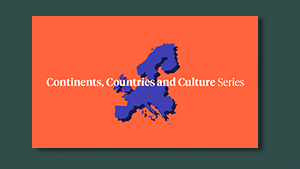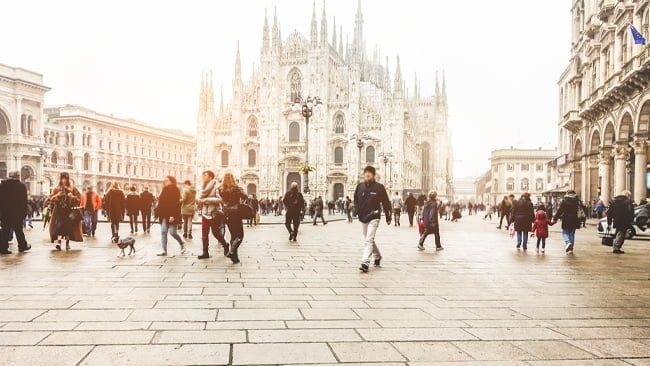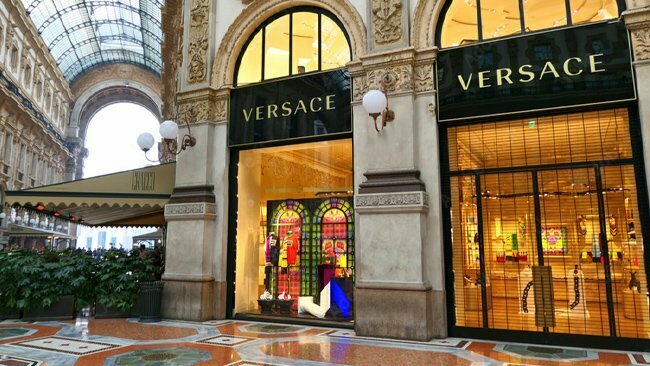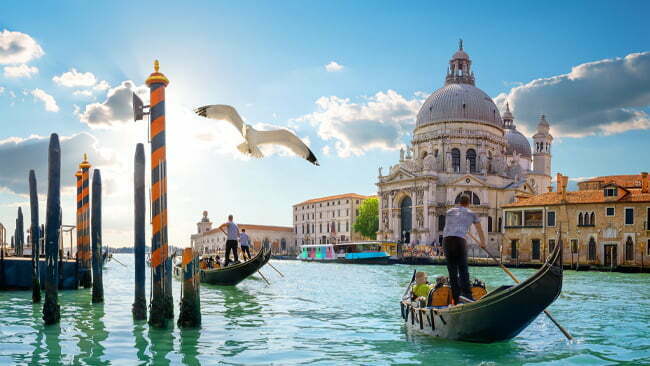Italy: Country, Culture and Customs

The beautiful country of Italy is in southern Europe on a peninsula in the northern Mediterranean. The country has a unique shape, resembling a boot, which makes it instantly recognizable on maps. Covering a total area of 301,340 km2 (116,342 mi2), Italy has some of the most scenic landscapes on Earth, ranging from the rugged mountains of the Alps to the beautiful islands of Sicily and Sardinia.
Italy’s culture combines centuries of heritage and tradition with roots back to the Ancient Roman Empire. Its country’s culture is rich in the arts, food, architecture, family, and music and is home to legendary figures such as Julius Caesar, Augustus, and Nero. Italy was also the birthplace of fascism under Benito Mussolini, as well as the Renaissance.
Italian culture has flourished for thousands of years. Below are some interesting facts about Italy’s culture, country customs, and traditions.
Population
The population of Italy is estimated to be 58,870,762 (as of January 2023), which is a 0.28% decline from 2022. The largest city is Rome, with 2.3 million residents, followed by Milan, with 1.2 million residents, and Naples, with almost 960,000 residents. These three cities are the largest in Italy, and Rome is the capital and the fourth most populous city in the European Union.
Languages of Italy

Italian is the official language of Italy, with 94% of the population speaking it as their native tongue. It is known as a Romance language, a descendant of Latin, and it developed from the Tuscan language of Florence in the 14th century, which has influenced today’s standard Italian.
Regional languages also exist, such as Sicilian, Sardinian, and Lombard. It is important to note that these are not dialects but distinct languages, and they sound quite different from Standard Italian and may be difficult to understand. Languages of the northern regions are closer to French and Occitan than those of the south.
Religion in Italy
Throughout Italy, Christianity has been the predominant religion since the 1st century. Most Christians adhere to the Catholic Church, whose headquarters remain in Vatican City, Rome. Italians and the Church have a special relationship since the Pope is the world’s leader of the Catholic Church and the Bishop of Rome.
83.4% of Italy’s residents are Christians, 12.5% are unaffiliated, atheist, or agnostic, 3.7% are Muslims, and 0.4% adhere to other religions such as Buddhism, Hinduism, and traditional beliefs.
Family Life in Italy
Family is at the center of the social structure in Italy and provides a stable influence for all its members. The Italian culture is highly family-oriented, and it is popular to live with extended family like grandparents, aunts, uncles, and cousins. If you live separately from your extended family in Italy, they are usually within walking distance or a short drive away. In addition to living close to one another, a typical Italian family gets together at least once a week, ideally on a Sunday, for a big dinner, usually at someone else’s house.
Families in the South are typically extended, while those in the North are more likely to be nuclear families (the core family members, e.g., two parents and their children); in both cases, grandparents provide childcare when both parents work.
Italian Food
 Food plays an integral part in the Italian lifestyle. The Italian food culture has influenced people worldwide with its fresh Mediterranean ingredients, homemade bread, pasta, olive oils, and rich meats. Eating in Italy is more than just satisfying hunger; it’s a way to bond with family and friends while meeting and enjoying each other’s company.
Food plays an integral part in the Italian lifestyle. The Italian food culture has influenced people worldwide with its fresh Mediterranean ingredients, homemade bread, pasta, olive oils, and rich meats. Eating in Italy is more than just satisfying hunger; it’s a way to bond with family and friends while meeting and enjoying each other’s company.
Dining is almost a ritual to many Italians, beginning with the aperitif or glass of wine, followed by heart-warming food, which ends with the inevitable coffee with friends. Typically, Italians eat three meals a day: breakfast, lunch, and dinner; their importance is also in creating a warm and welcoming environment, which is fundamental to their culture.
Italy Art and Architecture
When it comes to art and architecture, you have a plethora to choose from in Italy. It was during Italy’s Classical period that their most monumental buildings were constructed, with key features such as columns, arches, and vaulted ceilings. It is mainly due to the cement-based concrete that Italy’s Classical structures have lasted so long. The Romans invented this revolutionary material to construct many iconic structures in Rome.
Italy’s Renaissance lasted from the 14th to the 17th centuries and remained one of its most defining periods in art and architecture. As well as being the era of great creative geniuses like Leonardo da Vinci and Michelangelo, it was also the time when some of Italy’s most eye-catching and beautiful buildings were erected. A Renaissance building is characteristically symmetrical and often incorporates classical-influenced elements such as arches, columns (both structural and decorative), and imposing facades. With his design for the prestigious St. Peter’s Basilica in Vatican City, Donato Bramante is one of the most influential Renaissance architects.
Most of Italy’s well-known structures were built centuries ago, but it also has some modern buildings in its larger metropolises. Designed in a classical Roman style, Rome’s MAXXI National Museum of 21st Century Art is an outstanding example of modern Italian design. Numerous great museums exhibit contemporary art in Italy, including the Museo d’Arte Contemporanea in Rome and the Galleria Nazionale d’Arte Moderna in Milan.
Italian Fashion
 Italy experienced a period of great artistic development between the 11th and 16th centuries, with cities such as Rome, Palermo, Venice, Milan, Naples, Florence, and Vicenza producing luxury goods, jewelry, and hats. However, between the 17th and early 20th centuries, Italian fashion declined in importance, and France became the dominant fashion influence in Europe. The “Italian school” eventually competed with French haute couture in 1951–53, and Gucci and Ferragamo surpassed Chanel and Dior. According to the Global Language Monitor, Milan was ranked as the world’s top fashion capital in 2009, and Rome was fourth. Now, Milan stands alongside New York, Paris, and London as one of the “big four” global fashion capitals.
Italy experienced a period of great artistic development between the 11th and 16th centuries, with cities such as Rome, Palermo, Venice, Milan, Naples, Florence, and Vicenza producing luxury goods, jewelry, and hats. However, between the 17th and early 20th centuries, Italian fashion declined in importance, and France became the dominant fashion influence in Europe. The “Italian school” eventually competed with French haute couture in 1951–53, and Gucci and Ferragamo surpassed Chanel and Dior. According to the Global Language Monitor, Milan was ranked as the world’s top fashion capital in 2009, and Rome was fourth. Now, Milan stands alongside New York, Paris, and London as one of the “big four” global fashion capitals.
Doing Business in Italy
The Italian economy is the eighth largest in the world and is historically known for its role in manufacturing, food & wine, design, and research. Along with its glamorous image, it is no surprise that many people want to do business in Italy.
Doing business in Italy can be challenging due to bureaucracy, a complex tax system, and cultural differences. It is therefore essential to be patient and persistent, as the decision-making process can be slow. However, the Italians have a strong work ethic, high-quality products, and a well-educated workforce, making it a valuable market for international companies.
Italian society is centered around the family, which also factors into how Italians do business. Many of Italy’s companies are family-owned. In a business environment, this manifests as decisions made from the top down by business owners or a small group of family members. A lot of time in Italian business is spent networking and maintaining business relationships. Italian business respects seniority, although the power of individual managers is often determined by how well they get along with those above them.
Italy Holidays and Celebrations
Italians celebrate 12 official public holidays every year. These days include national and religious holidays, which are widely observed by most of the population. Public holidays in Italy are marked by the closure of schools and post offices, and many private businesses also close. However, in recent years, more and more have stayed open on these days. Some significant monuments, such as the Colosseum, remain open throughout the year, except during Christmas and New Year’s Day. The complete list of Italy holidays is as follows:
 New Year’s Day: January 1
New Year’s Day: January 1- The Epiphany: January 6
- Easter Sunday: April 9
- Easter Monday: April 10
- Liberation Day: April 25
- Labor Day: May 1
- Republic Day: June 2
- Assumption Day: August 15
- All Saint’s Day: November 1
- The Feast of the Immaculate Conception: December 8
- Christmas Day: December 25
- St. Stephen’s Day: December 26
Out of the above-listed holidays (aside from Christmas, Easter, and New Year), Assumption of the Virgin, Republic Day, and Labor Day are the most celebrated in Italy.
Common Italian Language Expressions
Known for their creativity and passion, Italians have certain common language expressions they love using. The following Italian expressions are the most popular:
- Mamma mia! – Expresses surprise, happiness, sorrow, or impatience.
- Che bello! – This phrase means ‘How lovely!’ Or ‘How nice!’
- Uffa! – Expresses boredom or anger.
- Che ne so! / Boh! – This phrase means they have no idea about something.
- Magari! – Expresses hope, e.g., ‘if only’ or ‘I would love to!’.
- Tis ta bene! – The Italian way to say: ‘it looks good on you’ or it could also mean ‘serves you right!’
- Non te la predere! – A way to console someone, e.g., ‘don’t worry’ or ‘don’t get upset.’
- Che macello! – This phrase means ‘what a mess!’.
- Non mi va! – Expresses when they do not want to do something, e.g., ‘I don’t feel like it.’
- Mi raccomando! – Expresses an emphasis when asking for something, e.g., ‘please, I beg you!’.
Translation for the Italian Market
Marketing translation services are a valuable tool for any business looking to reach new customers in the Italy market. Translating your marketing materials into Italian is a powerful communication strategy. It can help your company reduce the distance between you and your Italian clients, demonstrating your commitment to their business.
At GPI, we have extensive experience in the Italian-speaking market. Our talented team of Italian translators can assist you with your Italian marketing materials and work closely with you on a wide range of translation projects.
